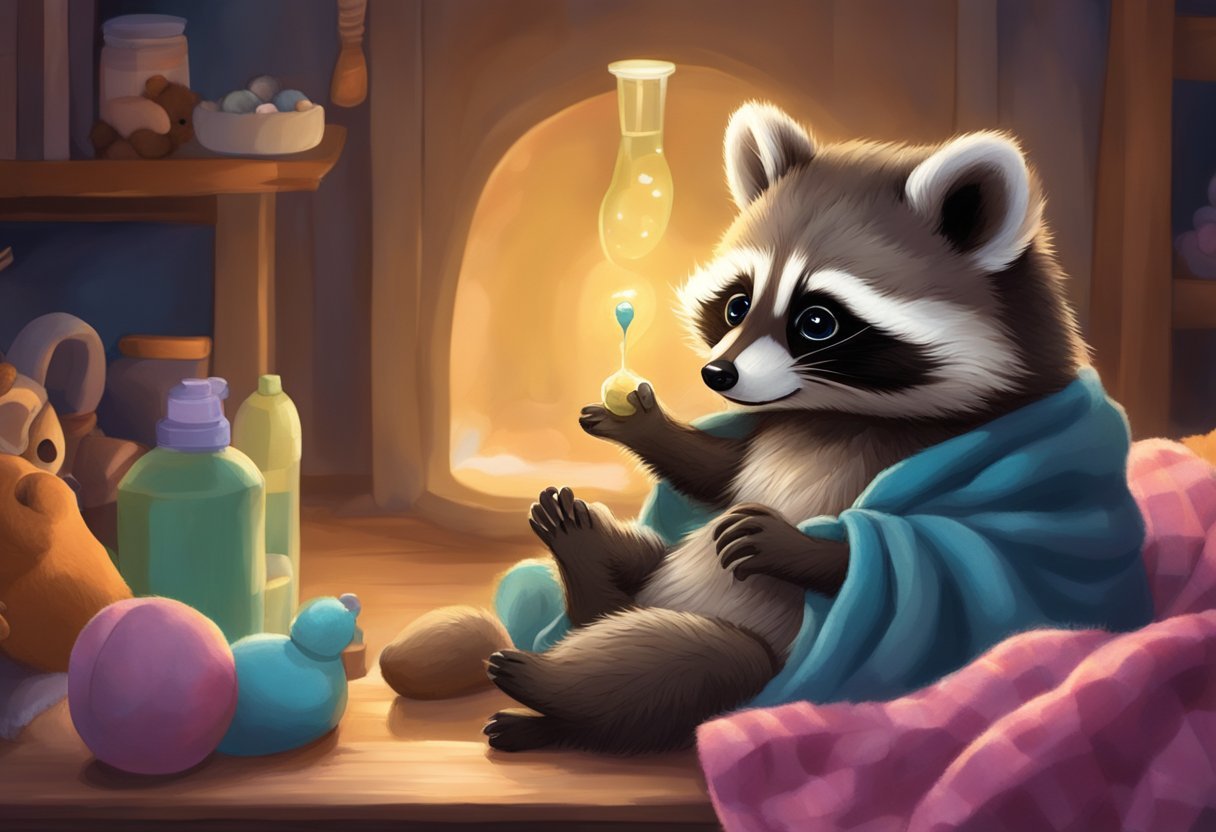How to Care for a Baby Raccoon: Essential Tips and Guidelines
Caring for a baby raccoon requires dedication and proper knowledge. Providing the right diet and creating a safe environment are crucial steps in taking care of raccoons. Knowing how to handle and interact with them ensures they grow healthy and strong.

One important aspect is to understand their dietary needs. Baby raccoons need a balanced mixture of formula, fruits, and proteins. It’s essential to feed them at regular intervals and monitor their growth.
Creating a safe habitat helps prevent injuries and stress. A warm, quiet space with suitable bedding is ideal. They should be shielded from predators and extreme weather conditions for their well-being.
Understanding Baby Raccoons
Baby raccoons, also called kits, have distinct physical and behavioral traits. Knowing these helps in providing proper care.
Characteristics and Development
Baby raccoons are born with their eyes closed and fur that is soft and thin. Their eyes usually open after two to three weeks, revealing dark, round eyes. At this stage, they start exploring their environment. Their fur becomes thicker and more defined with the classic black and gray coloring by the time they are about a month old.
By six weeks, baby raccoons begin developing their teeth, which is a sign that they are ready to start eating soft solid foods. They are highly vocal and use a variety of sounds to communicate. These sounds range from purrs and chirps to growls and hisses.
Behavioral Patterns
Kits stay close to their mothers for the first few weeks, relying on her for warmth and protection. They are curious creatures and tend to explore more as they grow older. By about eight weeks, baby raccoons become more independent and start practicing their climbing and foraging skills.
Their play behavior is important for development. Through play, they learn how to interact with others and improve their physical abilities. They usually prefer to be active during the night, displaying nocturnal habits even from a young age.
Legal and Ethical Considerations

When caring for a baby raccoon, it’s important to know the legal rules and think about the ethics involved.
Wildlife Laws
Caring for wild animals like raccoons is subject to many legal restrictions. In many places, it may be illegal to keep them as pets. Laws often require that baby raccoons be taken to licensed wildlife rehabilitators. This ensures the raccoons get proper care and can be released back into the wild.
Each state has different regulations about handling orphaned wildlife. Before taking any action, always check with local authorities or wildlife agencies. This helps avoid any legal trouble and makes sure the raccoon gets the best care possible. Fines and penalties can be severe if laws are broken.
Ethics of Raising Wild Animals
Raising wild animals takes special knowledge and resources. When people keep wild animals as pets, it can cause serious problems. Wild animals have different needs compared to domestic pets. For example, raccoons are naturally curious and can become destructive if not given proper care and environment.
Wild animals are also important for the ecosystem. Removing them from their natural habitat can disrupt local wildlife populations. Licensed wildlife rehabilitators are trained to take care of them and make sure they can return to the wild. This is the most ethical way to handle orphaned raccoons.
Initial Care and Assessment

If you find a baby raccoon, assessing its health and creating a safe environment are crucial steps. These actions ensure that the raccoon remains stable and comfortable before professional care.
Determining the Health Status
First, check if the baby raccoon is orphaned, abandoned, or injured. Observe its behavior and look for signs of distress such as crying or weakness. Examine its body for visible wounds or signs of dehydration like dry gums and sunken eyes.
Feel its body temperature. A healthy raccoon should be warm to the touch. If it feels cold, it may be in shock or suffering from exposure. A heating pad or hot water bottle wrapped in a towel can help.
Next, watch for symptoms of being sick. These might include lethargy, nasal discharge, or trouble breathing. Record these observations for when you contact a wildlife rehabilitator or veterinarian.
Creating a Safe Environment
Place the baby raccoon in a secure container with soft bedding. The container should have air holes but be escape-proof. Make sure it is located in a quiet, dark place to reduce stress.
Use a heating pad or hot water bottle wrapped in a towel to keep the raccoon warm but avoid direct heat contact. The temperature should be comfortable—not too hot or cold. Be vigilant in monitoring the raccoon’s comfort level.
Ensure the raccoon is hydrated. If it shows signs of dehydration, offer small amounts of water using a syringe, but do not force it. Keep the environment clean and check the bedding regularly for soiling.
Feeding and Hydration
Proper feeding and hydration are essential for the health of a baby raccoon. They need the right kind of food and regular feeding schedules to grow strong.
Preparing Food and Water
Baby raccoons require a special diet. For very young raccoons, puppy milk or kitten formula is suitable. These can be found at pet stores. Avoid cow’s milk as it can make them sick. Use a baby bottle with a small nipple designed for animals.
When they start to grow, introduce solid food slowly. Start with soft foods like canned kitten food or mashed fruits. Always provide fresh water in a shallow dish. Change the water daily to keep it clean.
Feeding Schedule and Techniques
Newborn raccoons need to be fed every 2-3 hours. As they grow, the frequency decreases. By the time they are a few weeks old, feeding every 4-6 hours is sufficient.
Hold the baby raccoon securely during feeding. Make sure the bottle’s nipple is the right size to prevent choking. Observe the baby raccoon for signs of fullness, like slowing down or turning away from the bottle. Weaning off the bottle should start around 6-8 weeks old. Introduce them to more solid foods gradually over this period.
Health and Daily Care
To ensure the well-being of a baby raccoon, monitoring health issues and maintaining a clean habitat are essential. Regular vet check-ups and a hygienic environment help keep common health problems at bay.
Monitoring Health Issues
Baby raccoons need regular health checks. They are prone to diseases like distemper, which can be fatal. Look for symptoms such as diarrhea, coughing, or a runny nose. Veterinarians can diagnose and treat these issues early.
Dehydration is another concern, often treated with Pedialyte. If a raccoon has digestive problems, a vet should be consulted. Keep an eye out for fly eggs, especially around wounds, as they can cause infections. Regular monitoring can catch these issues before they become serious.
Maintaining a Clean Habitat
A clean habitat is vital for preventing diseases. Daily cleaning is necessary to remove waste and uneaten food. Use safe disinfectants and ensure all cleaning materials are rinsed well to avoid harming the raccoon.
Maintain a proper heat source for baby raccoons, as they need warmth to stay healthy. Bedding materials should be changed frequently to avoid mold and parasites. By keeping the habitat clean, the risk of illnesses decreases significantly.
Socialization and Enrichment

To raise a well-adjusted baby raccoon, it’s important to ensure proper socialization and provide enriching activities. This includes regular human interaction and creating a stimulating environment for the raccoon to explore and play.
Human Interaction
Baby raccoons need regular human interaction to become comfortable around people. Handle them gently and frequently to get them used to touch. This reduces their stress and builds trust.
Playing with the raccoon helps develop its curiosity and social skills. Use toys that mimic natural activities like chewing and climbing. Avoid loud noises and sudden movements that might scare the raccoon.
Interaction should be positive and consistent. Spend short, frequent sessions with the raccoon rather than long, infrequent ones. This helps them become familiar with human presence and reduces anxiety.
Environmental Enrichment
Creating a stimulating environment is crucial for a baby raccoon’s development. Provide plenty of opportunities for climbing and exploring. Install climbing structures, such as branches or shelves, to encourage these activities.
Rotate toys to keep the environment interesting. Puzzle feeders and interactive toys can keep their minds active. Chew toys help satisfy their natural chewing instincts and prevent them from damaging items around your home.
Offer a variety of textures and items to explore, like leaves, sand, and water. This encourages natural behaviors and reduces stress. Playing and exploring are key to a raccoon’s mental and physical well-being.
Preparing for Release

Releasing a baby raccoon back into the wild requires careful preparation. Key aspects include teaching them survival skills and assessing their readiness for an independent life.
Teaching Essential Survival Skills
Baby raccoons need to learn how to find food on their own. A wildlife rehabilitator should introduce the raccoon to foraging. They should place assorted foods around the area, like berries, insects, and small animals. These foods mimic what they will find in the forest.
Fear of humans is essential for survival. Human contact should be minimized to help them develop this fear. This will ensure they stay away from human dwellings and reduce potential dangers.
Practicing denning is crucial. They should learn to create and use safe resting places. They can be provided with materials like leaves, sticks, and straw to practice building nests.
Assessing Readiness
Assessing if a raccoon is ready for release involves checking its physical health. It should be strong, without injuries, and weigh enough to survive in the wild.
The raccoon should demonstrate its ability to find and eat food independently. An independent raccoon will routinely find and consume wild food without assistance.
Observation of behavior is important too. They should display natural behaviors like climbing and hiding. A raccoon ready for release will avoid humans and show fear in their presence.
A wildlife rehabilitator will often use checklists to ensure all necessary skills and health criteria are met. Only when all these aspects are satisfied should the raccoon be released back into its natural habitat.
Handling Potential Dangers

Caring for a baby raccoon involves being aware of potential dangers such as predators, rabies, and damage from biting. It’s essential to recognize signs of danger and take steps to prevent harm.
Recognizing Threats
Baby raccoons are vulnerable to various predators like owls, foxes, and coyotes. Keeping an eye on the surroundings helps in spotting these threats early. Signs of predators nearby include rustling bushes, strange noises, or other wildlife behaviors.
Rabies is another significant threat. Raccoons can carry this virus even if they look healthy. Watch for symptoms like aggression, staggering, or excessive drooling. If you think a raccoon might have rabies, contact animal control immediately.
Preventative Measures
To protect a baby raccoon from predators, keep it in a secure, enclosed shelter. This should be a sturdy cage or pen that animals can’t break into. Place the shelter in an area that’s not easily accessible to wild animals.
Safety measures include wearing thick gloves when handling the raccoon. This helps prevent bites. Ensure the raccoon is up-to-date on vaccinations, especially for rabies. Talk to a vet for the best protection plan.
Taking these steps ensures the raccoon stays safe and healthy, and you avoid any potential harm. Keep monitoring the raccoon regularly to ensure its well-being.
Frequently Asked Questions

Caring for a baby raccoon involves feeding it appropriate foods, knowing how to assess its health, and understanding when to introduce solid foods. It is essential to provide the proper care for these young creatures to ensure their well-being.
What should I feed a baby raccoon at different stages of development?
Newborns need a specific milk replacer. As they grow, introduce soft foods like fruits, veggies, and protein sources.
How can I tell the age of a found baby raccoon?
Check for clues like fur thickness, eye development, and mobility. Younger raccoons have closed eyes and are less mobile.
What are the signs that a baby raccoon is healthy?
Healthy raccoons are active, have clear eyes, and a clean coat. They should also have a good appetite and no signs of distress.
How often should I feed an orphaned baby raccoon?
Newborns typically need feeding every 2-3 hours. The frequency can decrease as they get older and start eating solid foods.
What steps should I take if I find an abandoned baby raccoon?
First, ensure the baby is warm and safe. Contact a wildlife rehabilitator for advice on long-term care or potential reuniting with its mother.
When is it appropriate to introduce solid foods to a baby raccoon?
Soft foods can be introduced when the raccoon is about 6-8 weeks old. Start with small amounts to make sure they can digest it properly.







